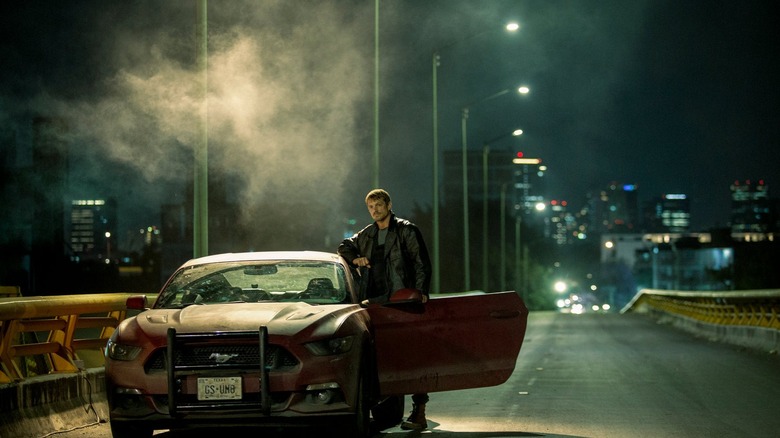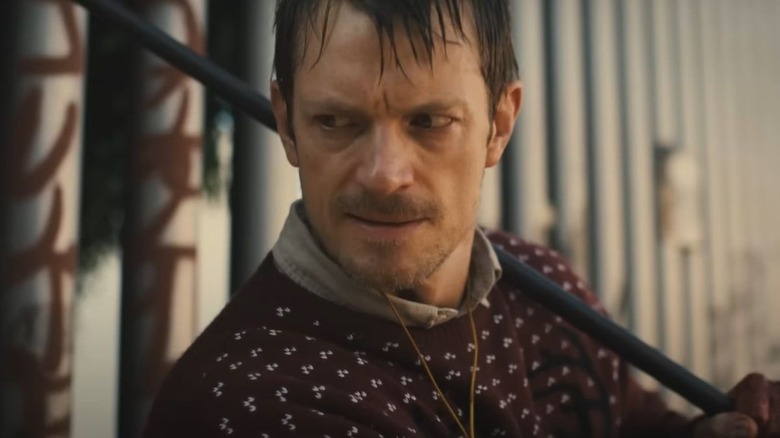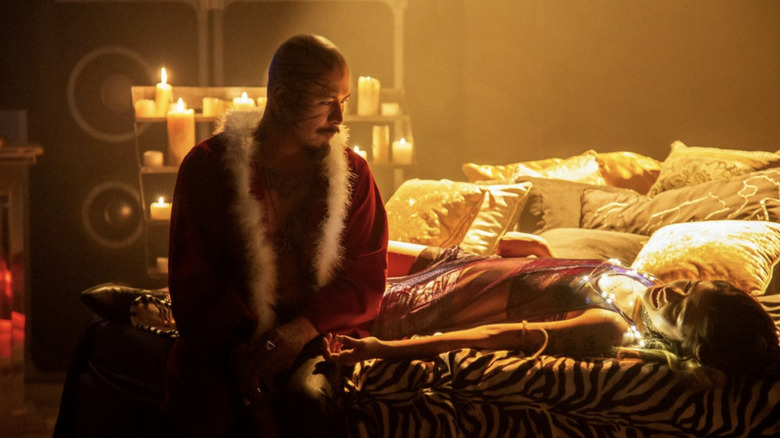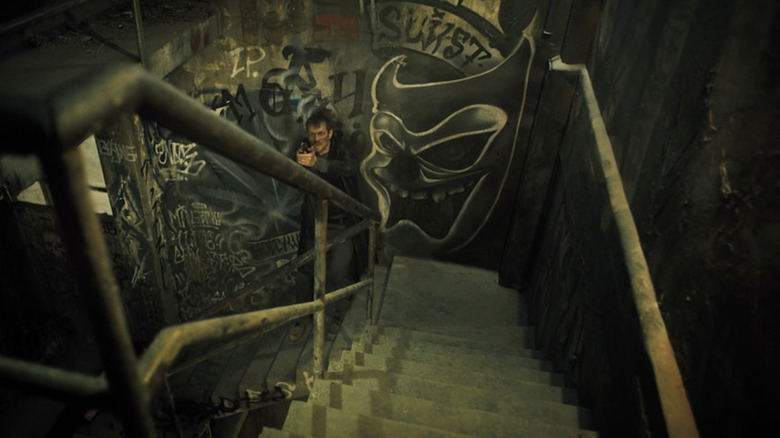Every John Woo Touch In Silent Night (And Everything That's Missing)
Let's be blunt: The current state of action cinema worldwide would not be what it is today without the work of director John Woo. While Woo is hardly the only influential filmmaker when it comes to action movies, he's undeniably one of the biggest figures in shaping the genre. Like any great auteur, Woo's style was developed film by film, working his way through his kung-fu features at Golden Harvest in Hong Kong and adding in more experimental techniques (gleaned from the likes of prior filmmakers such as Sam Peckinpah) until he ended up at his signature magnum opus, 1986's "A Better Tomorrow" and its style, which was dubbed "heroic bloodshed."
Over the next several years in Hong Kong and then through to his transition into Hollywood, Woo expanded his "heroic bloodshed" style, peppering in other influences along the way from some of his other favorite filmmakers like Jean-Pierre Melville and Alfred Hitchcock. After leaving Hollywood in 2004, Woo continued to make films in China, and didn't stop experimenting with his own personal style.
Cut to this very month, when Woo's comeback Hollywood feature, "Silent Night," is in theaters everywhere. The film is notably Woo's, and yet there's no question that the movie's aesthetic is different from such earlier efforts as "Hard Target" or "Face/Off." That's entirely intentional; as Woo told me himself recently, he sought to make "Silent Night" a feature where he tried to eschew his usual style. Here, then, are some examples of how "Silent Night" deviates from the Woo signature, as well as ways in which it surprisingly doesn't.
No dialogue, and nothing 'fancy'
Here's what Woo himself said about approaching "Silent Night" with a new aesthetic in mind:
"I got rid of my usual style. My usual style is like too many gunshots, too fancy. I need to show the real fight, the real anger, the real hatred for the crime. So I'm using some new techniques, like most action sequences I'm using a long take, a long take without any cuts, without shutting the camera, to make the audience feel it's real. Every punch, every hit, always sounds real and looks real. So I think you've got more of a good impact, and it also makes the audience more involved with the character. Not only just fights."
Part of this approach was dictated by Robert Archer Lynn's script for the film, which indicates that Brian Godlock (Joel Kinnaman) cannot speak after being shot in the throat by the gang leader, Playa (Harold Torres), who inadvertently killed Godlock's son. Following that conceit, Woo makes the action in "Silent Night" far more gritty than his "heroic bloodshed" films, and certainly not as operatic as he did in "Face/Off" or "Mission: Impossible II." It's an instance of a filmmaker fitting his style to his lead character, as Godlock learns to become a killer over the course of the film from YouTube videos and other available sources, meaning he's far from a professional when he embarks on his mission of revenge.
However, Woo's use of long takes is not something new to his work. While the takes in "Silent Night" run on in part to demonstrate just how dangerous and hard Godlock's quest is, Woo's been using the long take in his action for a while — most notably in 1992's "Hard Boiled," which features a fight scene that runs an unbroken 2 minutes and 42 seconds long.
Darkness instead of doubles
Speaking of opera and/or the theatrical within Woo's work, many of his prior films have worn that particular aesthetic on their sleeve, with the action in them being described as "balletic," among other such evocative adjectives. "Silent Night" has a tighter focus on the action being hard-hitting rather than extravagantly choreographed, and thus cannot provide on its own the sense of theatre that Woo's other work does.
Another change is that Woo tended to evoke operatic, even mythic emotions through "doubling" his protagonists, drawing a clear line of relation between his Hero and his Villain. In addition to the more metaphorical examples, there exists the literal doubling of Castor Troy and Sean Archer in "Face/Off," as well as the face-swapping (through masks) of Ethan Hunt and Sean Ambrose in "Mission: Impossible II." In both films, the heroes and villains share love interests, making them part of an emotionally-charged love triangle (or quadrangle, as the case may be).
In "Silent Night," the relationship between Godlock and Playa is mostly one-sided; Playa barely knows who Godlock is until their final confrontation. Their love relationships are also muted, as Godlock's wife, Saya (Catalina Sandino Moreno), slowly grows apart from her husband before leaving him, and Playa's girlfriend seems to be present mostly to be the gangster's arm candy. That said, Godlock finds himself gradually sinking into moral ambiguity and darkness as he grows more obsessed with having his revenge, and by the climax of the film, he's essentially turned himself into the flip side of Playa's coin. Thus, "Silent Night" does end up containing a doubling with its characters, if only to point out how much Brian changes. As for the film's theatrical qualities, the lack of dialogue brings a larger tension to every look each actor gives, imbuing their physicality with that much greater meaning.
Woo(mp), there he is
Despite his making some bold new choices with "Silent Night," the movie is still very much Woo's film. While its pace is something new for the director, with the film going for long stretches without any action sequence or fight at all, its structure is very similar to his prior efforts, beginning with a literal bang of an action setpiece before introducing the film's premise and backstory. Then, of course, Woo saves the non-stop barrage of violence for the film's third act, letting punches, kicks, and gunshots literally escalate as Brian climbs the stairs of Playa's hideout in a series of long takes.
Some of Woo's signature visual elements are still present in the movie, they're just a little less conspicuous. One of Woo's most infamous visuals are the use of white doves, featured in his other films as a way of denoting the Hero's inherent goodness. When birds are seen in "Silent Night," they're either pigeons or parrots, something much more indicative of the morally grey qualities the hero and villain in this movie have.
Then, of course, there's that most badass Woo tic: The Dual Wield, where a character holds (and fires) two handguns at the same time. In "Silent Night," that honor goes to Detective Vassel, played by Scott Mescudi, AKA Kid Cudi. Not only is this fitting, given Cudi's real-life cool status and Vassel's less compromised character (doing what he does in the name of the law more than vigilante justice), but it serves to best point out how much Brian isn't portrayed as a heroic badass. "Silent Night" is, ultimately, a tragedy, and all of Woo's changes and subversions to his signature style serves this theme and tone. Above all, this proves that Woo isn't some style-over-substance director, but a truly thoughtful and responsible storyteller. As a result, it's that much more exciting to wonder where his style might go next.



